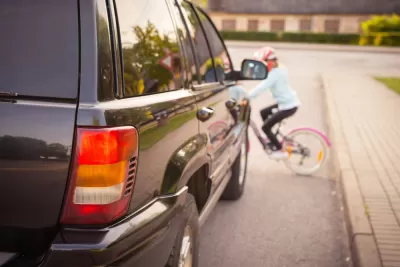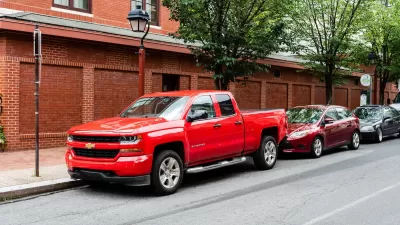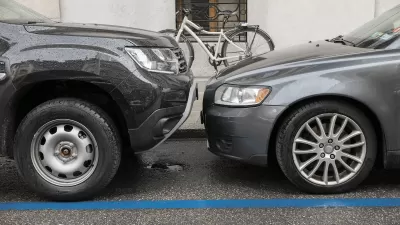Lawmakers want the federal government to set standards for vehicle height and visibility to combat the sharp rise in pedestrian deaths over the past decade.

The size of cars and trucks in the United States has ballooned over the past decade, and so have roadway fatalities, particularly pedestrian and cyclist deaths. Studies show there is a direct correlation. Lawmakers in Congress say enough is enough, reports NPR correspondent Joel Rose. Rep. Mary Gay Scanlong (D-Pa.) and co-sponsors introduced a bill last Friday called the Pedestrian Safety Act that “would require federal standards for hood heights and visibility to protect pedestrians and other vulnerable road users,” according to the NPR article.
The average U.S. passenger vehicle has gotten about 10 inches longer, 8 inches taller, and 1,000 pounds heavier, according to IIHS, and SUVs and pickups make up more than three-quarters of the vehicles on the road, up from 38 percent in 2009. And while studies show that larger vehicles tend to be safe with occupants, they are far deadlier for people outside the car. The NPR article cites an IIHS study that showed vehicles with higher front ends and blunt profiles are 45 percent more likely to cause fatalities in crashes with pedestrians than smaller cars and trucks.
“Safety advocates say that’s a big reason why annual pedestrian deaths in the U.S. are up more than 75% since reaching their lowest point in 2009,” Rose writes.
The bill would require the National Highway Traffic Safety Administration to set the standards, which would then apply to all new cars. According to the NPR article, it’s not the first time Congress has asked NHTSA to consider the safety of people outside of cars: “The Bipartisan Infrastructure Law directed the agency to expand its New Car Assessment Program to include pedestrians.” But safety advocates the resulting proposal for pedestrian crashworthiness testing had no teeth in that the program would be voluntary (meaning carmakers could opt out) and the pass-fail ratings would only be available through NHTSA’s website rather than on the five-star safety rating system that’s displayed on dealership car windows, where it has the most chance to inform consumers’ decisions.
Apart from pedestrian safety concerns, larger vehicles have additional implications for local, state, and federal governments. Bigger SUVs and trucks cause more wear and tear on roads, require more space to park, produce higher amounts of carbon emissions, and — as illustrated by this satirical cartoon — perpetuate America’s “car-is-king” approach to transportation.
FULL STORY: As cars and trucks get bigger and taller, lawmakers look to protect pedestrians

Alabama: Trump Terminates Settlements for Black Communities Harmed By Raw Sewage
Trump deemed the landmark civil rights agreement “illegal DEI and environmental justice policy.”

Planetizen Federal Action Tracker
A weekly monitor of how Trump’s orders and actions are impacting planners and planning in America.

The 120 Year Old Tiny Home Villages That Sheltered San Francisco’s Earthquake Refugees
More than a century ago, San Francisco mobilized to house thousands of residents displaced by the 1906 earthquake. Could their strategy offer a model for the present?

LA’s Tree Emergency Goes Beyond Vandalism
After a vandal destroyed dozens of downtown LA trees, Mayor Karen Bass vowed to replace them. Days later, she slashed the city’s tree budget.

Sacramento Leads Nation With Bus-Mounted Bike Lane Enforcement Cameras
The city is the first to use its bus-mounted traffic enforcement system to cite drivers who park or drive in bike lanes.

Seattle Voters Approve Social Housing Referendum
Voters approved a corporate tax to fund the city’s housing authority despite an opposition campaign funded by Amazon and Microsoft.
Urban Design for Planners 1: Software Tools
This six-course series explores essential urban design concepts using open source software and equips planners with the tools they need to participate fully in the urban design process.
Planning for Universal Design
Learn the tools for implementing Universal Design in planning regulations.
Ada County Highway District
Clanton & Associates, Inc.
Jessamine County Fiscal Court
Institute for Housing and Urban Development Studies (IHS)
City of Grandview
Harvard GSD Executive Education
Toledo-Lucas County Plan Commissions
Salt Lake City
NYU Wagner Graduate School of Public Service





























